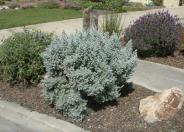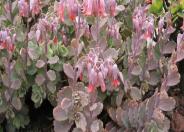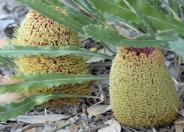
Common name:Smooth Agave
Botanical name:Agave desmetiana 'Variegata'
Agave with an open rosette form grows quickly to 3' x 3'. Very attractive plant resembles Octopus Agave but smaller. Fleshy leaves are light green with smooth edges and a sharp tip. Will grow best in filtered sun or full shade. After several years, flowe

Common name:Mescal Agave
Botanical name:Agave parryi
A tight medium sized rosette sometimes solitary, sometimes with offsets. The leaves can vary much in size and color. The flower spike is up to 20' in height with bright yellow and red buds in mid summer. Native in central and southern Arizona into New Mexico at 1000-8000'. One of the most cold hardy. Full sun or part shade but needs good drainage. Heavily toothed rosettes.

Common name:Cushion Bush
Botanical name:Leucophyta brownii
Cushion Bush is a low mounding shrub that grows 1-3' tall and 2-3' wide. It has tiny, narrow, silver green foliage that makes it an outstanding accent plant. Tiny yellow flowers appear on the end of the stems in spring and summer. This plant does well in full to part sun with minimal water. It tolerates coastal and windy conditions well. If regularly pruned, this shrub will maintain its density and longevity. It does best in well draining soil. Be careful not to overwater.

Common name:Ascot Rainbow Spurge
Botanical name:Euphorbia x martinii 'Ascot Rainbow'
Ascot Rainbow Spourge has narrow, grey-green leaves have a striking yellow edge. The foliage is topped by clusters of variegated cream, lime, and green flowers (bracts) in spring. In the cooler months, the foliage at the ends of the stems becomes flushed with shades of red, pink, and orange. In our location near Lake Michigan where summer temperatures are a bit cooler, a bit of the pink coloring remained all summer long. We did not observe any reversion in our trials. This plant would make a fabulous specimen in a brightly colored patio container and will undoubtedly add flair to the garden. As an added bonus, it is highly heat and drought tolerant.

Common name:Lavender Scallops
Botanical name:Kalanchoe fedtschenkoi
Kalanchoe fedtschenkoi is a low-growing perennial succulent with pretty flowers and compact foliage. The name of the plant honors botanist Boris Fedtschenkoi and is now known as Bryophyllum fedtschenkoi. Native to Madagascar, the plant belongs to the Crassulaceae family of plants and the genus Bryophyllum. Since its introduction to North America, it’s established itself in parts of the southern United States. It’s a relatively easy succulent to grow as a houseplant and it makes a great ground cover in suitable climates. You may hear it called by its common name including:
Lavender Scallops
Kalanchoe Stonecrop
South American Air Plant
Gray Sedum
Variegated Lavender Scallops
Kalanchoe fedtschenkoi ‘Variegata’ is a short, shrubby succulent typically reaching 1? – 2? feet tall. It features stems which spread out from the root along the ground, forming large colonies of thick succulent leaves. The blue-green leaves have cream-colored variegation along scalloped edges. The edges may turn red or pink under strong sunlight or drought conditions. The fleshy foliage is often darker green toward the center and trimmed with lavender. Each leaf may reach up to 2? inches and feature two to eight teeth around the edges. The stems are smooth and bendable. When the stems reach the ground, they may take root and grow new plants. In the late spring to early summer, the plant produces small bell-shaped flowers. The flowers hang loosely from upright stems. The loose clusters of flowers are often reddish-brown and only reach about 3/4-inch in size. Each flower has a short calyx and a slightly longer corolla. The plant is winter hardy in (USDA Zones) hardiness zone 9b or warmer. Outside of these areas, it’s typically grown indoors as a houseplant. It can tolerate temperatures below freezing for short periods. If temperatures regularly drop below 25° degrees Fahrenheit (-4° C), bring it indoors for the winter. The plant needs lots of strong sunlight (preferably full sun), whether grown indoors or outside, especially during the summer. Use porous soil with fast drainage to help prevent over-watering and mold growth. To make regular potting soil more porous, add sand or perlite. Lavender scallops require transplanting every few years. Transplanting allows you to replace the old soil with fresh soil and move up to a larger pot if necessary. When repotting, use caution around the leaves. The leaves are a little brittle and may snap when handled. When grown inside, place it near a south-facing or west-facing window.

Common name:Creeping Banksia
Botanical name:Banksia repens
Spreading prostrate shrub with fern-like foliage and yellow-brown to dull red flowers in winter-summer. Tolerant of most well-drained soils in full sun position. Drought and frost tolerant. Useful for erosion control, embankment planting and containers. It reaches about 1' tall and may spread up to 6' wide. Thus, a great plant for ground covers too. This evergreen plant does best in sandy soil. Use for cut flowers. From Western Australia.
Designer: Cricket Riley
Photographer: Vicki Anderson
Practice grass-cycling by leaving short grass clippings on lawns after mowing, so that nutrients and organic matter are returned to the soil.
Develop healthy soil for plants that are vigorous and naturally pest-resistant.